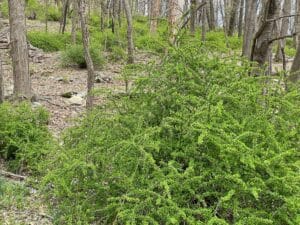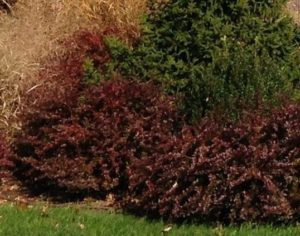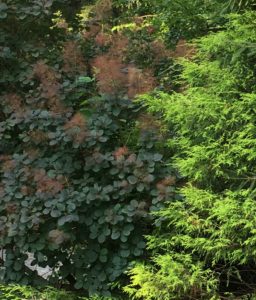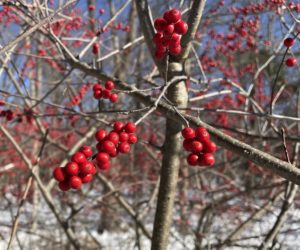
Invasive Barberry, taking over forest floors, stays green in shade.
Hello fellow lovers of all things Green,
Over-the-top spreaders, climbers, and self-seeders are known as garden thugs; a clever name that made me chuckle the first time I heard it. Barberry’s maroon leaves turn green in the shade, which is why the invasive bully is not as obvious to identify in the woodland areas. Thankfully, there are beautiful alternatives to barberry that are gaining popularity.
Why Baberry Became Popular
The maroon-leafed Japanese barberry has been overused in deer-populated areas for years, though it’s understandable why it’s so popular. They’re tough, their deep red foliage offers a lovely contrast in the garden, and deer don’t eat them. Additionally, their slender, red berries, prized for their ornamental value, linger long after the leaves drop.

Berberis thunbergii has been overused for years.
It was introduced here as a landscape plant in the 1800s. And there are now two species of barberry that plague our forests — Japanese Barberry (Berberis thunbergia) and Common Barberry (Berberis vulgaris). Both thorny tyrants are on do-not-plant lists and banned for sale in many states, including New York and Pennsylvania. While barberry is not yet prohibited in New Jersey, using it in garden designs nowadays feels irresponsible.
Beautiful Alternatives to Invasive Barberry
Dwarf purple-leaved Weigela, such as Weigela florida ‘Wine and Roses’, ‘Midnight Wine’, or ‘Fine Wine‘, are gorgeous deer-resistant alternatives. Substitutes for the larger maroon leaf barberry are my favored Smoke Bush (Cotinus coggygria), growing ten to fifteen feet, though manageable with pruning. The smoke-like plumes of flowers give it its common name. Then there’s Eastern Ninebark (Physocarpus opulifolius) – ‘Diablo,’ my favorite, which grows four to eight feet, or more, although you can maintain its size. To avoid losing the white fluffy flowers, prune it right after the blooms fade, as it blooms on old wood.
The straight species of Ninebark (Physocarpus opulifolius) is native to the central and eastern portions of the United States and from Minnesota and Colorado to South Carolina, Tennessee, Illinois, and Arkansas. It is also in Canada. But it’s the cultivar ‘Diablo’ that boasts the dark maroon leaves that former barberry lovers will adore.

Cotinus coggygria with Chamaecyparis pisifera allowed to grow into their feathery, full-bodied selves.
For an alternative to Gold Barberry, Golden Jackpot Weigela (Weigela florida ‘MonRigney’) is a winner. Of course, there’s Gold Thread Cypress (Chamaecyparis pisifera’ Aurea Nana’). Folks also call them Gold Mop and tend to plant them next to barberry, chopping them into yellow and maroon meatballs. Instead, may I suggest that you allow Gold Threads to stand alone so they can grow into their feathery, full-bodied selves?
The development of sterile barberry plants is underway, and a few have made it to market, such as ‘Sunjoy Mini Maroon’ Barberry, which grows 2 to 3 feet tall and wide.
Native plant alternatives to invasive barberry

Winterberry adorns winter landscapes and helps wildlife.
Better yet, while they don’t sport maroon leaves, why not replace your invasive barberry with thornless native lovelies, such as Virginia Sweetspire (Itea virginica) and Winterberry (Ilex verticillata), or Summersweet (Clethra alnifolia).
I adore native plants and incorporate them into designs whenever possible, as well as their cultivars, often referred to as “nativars.” But I am not averse to ornamental plants if they aren’t invasive or harmful. I encourage clients to aim for a 70 percent native to 30 percent ornamental ratio and have less lawn to help provide more habitat for our precious wildlife—a beautiful thing.
Let us propagate harmony.
May we never take our freedoms, choices, or the beauty and importance of the natural world for granted. Let us embrace our differences in the spirit of recognizing that we are all the same, seeking happiness and peace, and caring for our families. The same is true of wildlife. Let us all strive to propagate harmony. It starts at home and in our communities.
Garden Dilemmas? AskMaryStone@gmail.com and your favorite Podcast App.
There’s more to the story in the Garden Dilemmas Podcast:
Other posts and podcasts you’ll enjoy:
Episode 142. Berries for Winter Beauty and Wildlife
Berries for Winter Beauty and Wildlife – Blog Post
Episode 211. Truth and tale of two Country Gardens
Beaver or Woodchuck? What to do? – Blog Post


